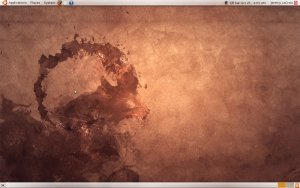Author: Jeremy LaCroix
Each new Ubuntu release has raised the standard by which other Linux distros are judged. With the new Ubuntu 8.10 Intrepid Ibex, the focus is on mobility and 3G network support. I found Intrepid to be a fast and stable release, yet I experienced some minor issues that keep it from absolute perfection.
I installed the 64-bit version of Intrepid on both my desktop computer and my laptop, which is a Gateway M-7315u with a 2GHz Pentium Dual Core T3200 Processor and 4GB of DDR2 RAM. When it comes to installing Ubuntu, you have the same options this time around as you did before, with one extra. The live CD installer is apparently unchanged. If you prefer a simpler text-mode installer, an alternate CD is available too. New to Intrepid is the “create a USB startup disk” option under the System -> Administration menu of an installed system, which allows you to install the OS on a USB flash drive. It was possible to install Ubuntu on a flash drive before, but having a utility available to do it for you makes it much easier. Installation for me took around 10 minutes on my laptop and 15 minutes on a flash drive.
The latest incarnation of Ubuntu includes the usual desktop manager upgrades. Ubuntu now sports GNOME 2.24, Kubuntu uses KDE 4.1.2, and Xubuntu gains XFCE 4.4.2. Across the board, Intrepid uses Xorg 7.4 and Linux kernel 2.6.27. Applications have been upgraded as well, with Firefox 3.0.3, Pidgin 2.5.2, and Rhythmbox 0.11.6 all being included, to name a few.
The Human Murrine desktop theme, a new option in Ubuntu 8.04, has become the default now. While there isn’t a huge difference between the previous default theme and the new one, the widgets and buttons look cleaner and more colorful. A completely new theme was promised for this release, yet didn’t materialize. The updated Human theme is not bad, yet a break from the Human style all together would have been appreciated. Thankfully, the Ubuntu community came together and created several alternate themes for the new release (Dust, Kin, and New Wave), yet none of those are installed by default. They can be found only in the community-themes package from the default repositories. Kubuntu sees the least customization of the Intrepid family when it comes to its look and feel. Other than slight color changes, it looks almost identical to a vanilla KDE 4.1 live CD and didn’t even get a customized login screen.
Ubuntu’s new focus on mobility seemed to pay off well for my laptop. The integrated wireless network adapter, audio, volume keys, and even the video card were all detected perfectly and worked without a hitch right from the first boot. I had no problems hibernating or suspending. Performance-wise, Intrepid ran very fast on both my laptop and desktop, with speed equal to or slightly greater than the previous release.
Network Manager 0.7 also finds its way to Intrepid. With this new version, you aren’t required to log in to get an Internet connection (guest sessions are available) and it also contains support for 3G (GSM/CDMA), PPP, and PPPOE connections, and more.
Also making its debut is Dynamic Kernel Module Support (DKMS), which is a framework by Dell that allows kernel drivers to be automatically rebuilt when new kernels are released. This should help to prevent situations in the future where an updated kernel is installed before a matching restricted-drivers package has been released, causing breakage.
The Kubuntu variant of Intrepid has completely dropped support of KDE 3.5.x. While I personally favor KDE 4.1, those who prefer the simplicity and proven stability of KDE 3 will feel left out. Although there is a user-created repository available for those who still wish to use KDE 3, it’s not officially supported, there’s no guarantee how long it will be available, and it will likely break KDE 4 if you have that installed too. However, with Intrepid, KDE 4.1 is solid and consistent.
On the downside
During the beta, there was a bug that prevented gamepads and joysticks from working properly. Instead, those types of devices were detected as mice, and even pressing a direction button would move the mouse cursor. This bug was fixed in the 32-bit flavors of Intrepid, yet at the time of this writing, this issue hasn’t been patched for the 64-bit editions yet. This may be an issue for those who use 64-bit and enjoy playing computer games. A patched package is available from Ubuntu’s launchpad that resolved this issue for me.
I experienced other hardware issues as well. On my desktop, I noticed that with two Nvidia video cards installed, I had to edit the xorg.conf file manually to be able to break away from text mode and get an X server. On my laptop, the brightness controls aren’t supported at all. Finally, my Lexmark printer doesn’t work anymore, causing me to have to boot into Windows in order to print a document.
In order to install Ubuntu on my flash drive, I had to download the ISO image again. It would have been easier if the installer would use the system components already installed. Booting from the flash drive after it’s created takes a very long time, yet thankfully the speed of the basic components is comparable to a hard drive install once it’s running. Also, the installation you get on your flash drive is an exact copy of the live CD, so you’ll have to add users and customize the settings to match your hard drive install yourself.
Overall
Intrepid had big shoes to fill after Hardy and ended up doing a pretty decent job. When you’re ready to try it, install the live CD first, to make sure that all of your hardware is detected properly before you commit to a full install. Overall, Intrepid is fast and stable, and the new focus on mobility is well appreciated.
Categories:
- Ubuntu
- Reviews
- Linux
- Distributions



